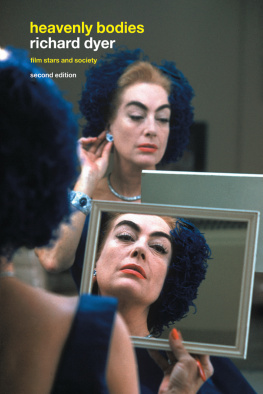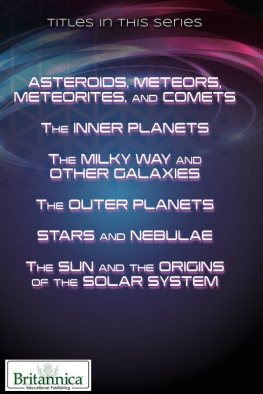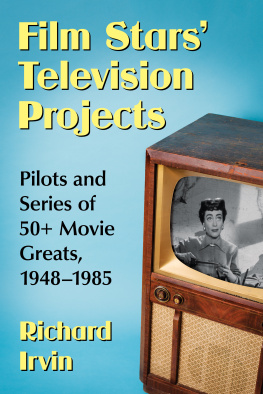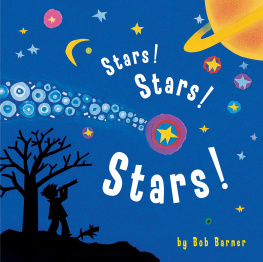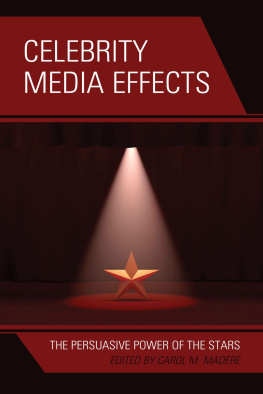Richard Dyer's classic and highly influential study of film celebrity has been reissued in this second edition as a testament to the enduring appeal of cinema's major stars.
Focusing on the lives and careers of three of the biggest names in Hollywood history Marilyn Monroe, Paul Robeson and Judy Garland he details how their screen image was constructed.
Through subtle readings of their films and a wealth of background material, he goes on to survey the development of each star's image in relation to particular social groups. Monroe is discussed in the context of 1950s sexuality and her perceived status as a victim of patriarchy; Robeson in terms of black identity and how he used his status to further anti-racist and socialist causes; and Garland as a gay icon.
Heavenly Bodies
Film Stars and Society
Second edition
Richard Dyer

First published 1986 by Macmillan Education Ltd
Second edition first published 2004 by Routledge
2 Park Square, Milton Park, Abingdon, Oxon, OX14 4RN
Simultaneously published in the USA and Canada
by Routledge
270 Madison Ave, New York NY 10016
Routledge is an imprint of the Taylor & Francis Group
Transferred to Digital Printing 2006
2004 Richard Dyer
Typeset in Times by Refinecatch Limited, Bungay, Suffolk
All rights reserved. No part of this book may be reprinted or
reproduced or utilised in any form or by any electronic,
mechanical, or other means, now known or hereafter
invented, including photocopying and recording, or in any
information storage or retrieval system, without permission in
writing from the publishers.
British Library Cataloguing in Publication Data
A catalogue record for this book is available from the British Library
Library of Congress Cataloging in Publication Data
A catalogue record has been applied for
ISBN 0415310261 (hbk)
ISBN 041531027X (pbk)
Contents
Illustrations
Preface
The main purpose of this volume is to suggest by example how general ideas about the stars can be thought through in particular cases. Three issues emerging from previous work on them have especially informed this book. First, the need to find a way of understanding the social significance of stars which fully respects the way they function as media texts, yet does not fall into a view of a given star as simply reflecting some aspect of social reality that the analyst cared to name. It is through the concept of discourses that I have sought to bring together the star seen as a set of media signs with the various ways of understanding the world which influenced how people felt about that star.
Second, a major gap in work done on the stars, and indeed in media and cultural studies generally, is the role of the audience. I have sought to redress this by talking about how people could make sense of the star, the different ways in which he or she was read. The chapter on Garland is fully focused on this concern, since it is entirely concerned with how a particular subculture read a particular star, but the chapters on Monroe and Robeson also develop the idea that there were different audience readings of these two stars and that something of the range of these readings needs to be understood. I am working throughout with the idea of shared ways of reading, not with individual readings (or totted-up individual readings, the basic approach of audience surveys).
Third, stars relate to very general ideas about society and the individual, ideas that I have sketched in the opening chapter. Much of the general impulse behind the interest in these ideas is political, stemming equally from two sources on the one hand, a recognition of the failure of traditional left politics to think hard and feelingly enough about the human person, resulting in a tendency to lurch between a mushy humanism and the inhumanity of most communist regimes; and on the other hand, the growth of feminist and gay politics that have put directly on to the political agenda questions of emotions, sexuality, everyday life and more generally what being a person is and can be. Some of the ideas that stem from these political concerns are explored in .
A further political concern underpinning the book is the issue of representation. It has become increasingly clear that at all levels how we think and feel we are, how we are treated, is bound up with how we are represented as being. This becomes a directly political issue when groups decide that they do not accept or else wish to change the way they are represented. The choice of stars for extended study in this book relates to this concern. Monroe and Robeson are key figures in any debate about the representation of women and whiteness, blackness and masculinity. Garland, on the other hand, leads to a discussion of the culture produced by gay men, thus telling us not about how gay men have been represented by the dominant media but how gay men have used an image in the dominant media as a means of speaking to each other about themselves. All three are important because of the political value that has been claimed for them Monroe has been seen as an exemplary figure of the situation of women in patriarchal capitalism; Robeson consciously tried to use his fame in an anti-racist and socialist way; Garland raises the question of the worth of subcultural practices with no explicitly political intent. The three may thus be seen not only as case studies in the analysis of stars, but as contributions to thinking about such political issues as how do we understand how a given group of people are placed by the media? What are the possibilities of political intervention in the media? How can people as audiences use the media? How important are subcultures?
Richard Dyer
Acknowledgements
No book is the product of one person, even if that person gets his or her name above the title; and the older you get the more people you have to thank. Rather than list all those whose thoughts, ideas and even casual remarks have made this book, and rather than risk leaving some individuals out, I should just like to thank the following the library, the National Film Archive Stills Collection, Jim Adams and projection staffs of the British Film Institute; Ed Buscombe and Roma Gibson for help in preparing the text for publication; David Meeker, Bill Everson, George Eastman House and MOMA for help with Robeson material; Simon Crocker (John Kobal Collection); and Christine Gledhill and Jean McCrindle for their comments on earlier versions of the Monroe chapter. I have presented the work in the following chapters in various forms to many different groups of people and always their discussions have fed back into the chapters.
The Robeson chapter is dedicated to Jaime Credle; the Garland chapter to Michael Walker and the late Drew Griffiths.
Richard Dyer
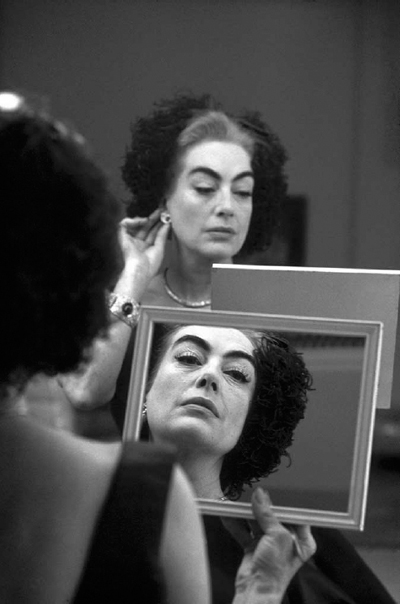
Frontispiece Joan Crawford by Eve Arnold ( Magnum Photos)

